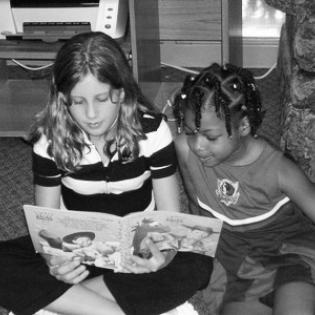Reading to Elementary Children
Learners increase their reading fluency and awareness of philanthropy by reading to younger children.
The learner will:
- demonstrate fluency, dramatic emphasis, and awareness of audience while reading a storybook aloud to children.
- define philanthropy as giving time, talent, or treasure and taking action for the common good.
- a selection of picture books for read-aloud
- Learning to Give's literature guides feature a diverse selection of books with themes of community and generosity.
Contact an elementary classroom or preschool teacher and set up a day and time for the young people to visit them and read aloud.
- National Center for Education Statistics [http://nces.ed.gov/naal/]
- National Right to Read Foundatioin [http://www.nrrf.org/research-archive/#national-studies]
- U.S. Department of Education: National Institute of Literacy [http://www.statisticbrain.com/number-of-american-adults-who-cant-read/]
Instructions
Anticipatory Set:
Share a favorite memory with a book and ask young people to share memories of someone reading aloud to them. Talk about favorite stories that were read to them and early books that they learned to read. What lessons do they recall learning from picture books? Book discussions can help us be kinder and more aware of new ways of thinking and being.
Talk about how early reading experiences help children learn to read. Give the learners independent time to research current facts about literacy. Meet together and discuss the importance of literacy, the state of literacy, and the causes and effects of not being a reader.
Explain to the learners that they are going to be matched with younger children and share a favorite book. They will use their skills and kindness to help younger students become better readers. They will also read books that have themes of being kind and responsible in their community.
To provide guidance for the young people to read to younger children, model the following read-aloud techniques, using a book from Learning to Give's Literature Guides (which include discussion questions that relate to generosity and community).
- Choose a reading space away from others. Introduce yourself and learn the name of the child(ren) you are reading to.
- Name the title, author and illustrator.
- Read slowly and with dramatic emphasis (after having practiced alone to gain fluency).
- Hold the book so others can see the pictures.
- Point out how the pictures add meaning to the story.
- Discuss the community-centered ideas of the story. Talk about connections to their lives.
Divide the young people into groups of three so they can practice reading aloud some of the book selections. Encourage team members to provide helpful suggestions to improve the readings. Tell them to each pick their favorite book from the selections that they can read aloud to a child when they are matched up.
Take as much time as needed to give the young people practice reading before the day they visit the younger children.
On the pre-arranged day, travel to the elementary or preschool classroom. Match up the children for the reading buddy activity. They follow the process modeled for them above.
Reflect with the group of younger children about the buddy experience and make a plan for the next visit.
After returning from the read-aloud sessions with the younger children, reflect on how it went. What went well? What did the younger child learn and what is needed next time?
Define philanthropy as “giving time, talent, or treasure for the common good." Discuss whether the learners feel that their time spent with the elementary children was an example of philanthropy. By reading to the elementary children, were they giving of their time, their talent or their treasure? Did the book teach giving in some form?
Make a plan to use their time and talent to help the younger children again. Talk about why this is valuable for both groups.
Philanthropy Framework
-
Strand PHIL.I Definitions of Philanthropy
-
Standard DP 01. Define Philanthropy
-
Benchmark MS.1 Define philanthropy as individuals and organizations providing their time, talent, and/or treasures intended for the common good throughout history and around the world. Give examples.
-
-
-
Strand PHIL.III Philanthropy and the Individual
-
Standard PI 01. Reasons for Individual Philanthropy
-
Benchmark MS.1 Define and give examples of the motivations for giving and serving.
-
-
-
Strand PHIL.IV Volunteering and Service
-
Standard VS 02. Service and Learning
-
Benchmark MS.2 Identify specific learning objectives from the academic core curriculum that are being applied in the service-learning project.
-
-
Standard VS 03. Providing Service
-
Benchmark MS.1 Provide a needed service.
-
-
Standard VS 05. Integrating the Service Experience into Learning
-
Benchmark MS.2 Evaluate progress on the service-learning project before, during, and after the project.
-
-
